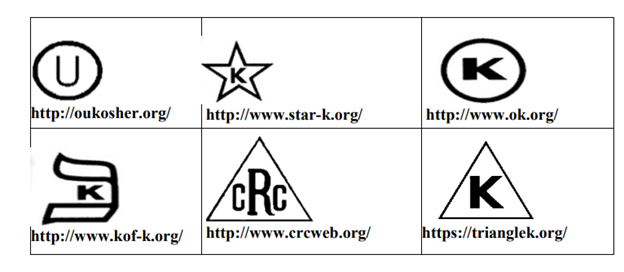
TEFAP Reach and Resiliency Grants Awarded
In June 2022, FNS awarded $39,419,932 in TEFAP Reach and Resiliency round one grant awards to 38 TEFAP State agencies. The TEFAP Reach and Resiliency grant is a competitive grant opportunity, for expanding TEFAP’s reach into remote, rural, Tribal, and/or low-income areas that are underserved by current TEFAP program operations. The first round of awarded projects represent a variety of unique and impactful projects, each tailored to the specific needs of the requesting State. More information regarding the projects awarded under round one can be found here.
|
USDA Foods with Commercial Kosher Certification
USDA is expanding the number of items on the Foods Available List (FAL) with commercial kosher certifications. Currently, the FAL for The Emergency Food Assistance Program has six kosher certified items. Current kosher certified offerings include canned tuna, canned salmon, peanut butter, applesauce, tomato sauce and canned garbanzo beans. Deliveries starting in January 2023 will include a requirement for all canned green beans, corn, and pears to have a commercial kosher certification.
Items with a kosher certification have been approved by a rabbinic agency and checked at each step of production to ensure that the products’ ingredients, production facility, and actual production process adhere to all kosher certified requirements. The vendor is responsible for making arrangements with a rabbinic agency of their choice. This process also ensures that all ingredients, derivatives, tools, and machinery have no trace of non-kosher substances. Items designated as kosher on the FAL are required to be certified kosher using one of six approved kosher symbols below.


Focus on Peaches and Nectarines
Fresh stone fruits are some of the newest bonus foods available! The USDA Agricultural Marketing Service (AMS) purchased peaches and nectarines for The Emergency Food Assistance Program in FY 2022 as part of the annual Section 32 (bonus) purchases.
Peaches and nectarines are part of the stone fruit family, a grouping of fruits whose flesh or pulp encloses a stone, along with apricots, plums and cherries. Peaches contain folate, potassium and iron, and are a great source of Vitamin A and Vitamin C. This combination of vitamins and minerals work together to support healthy red blood cells.
Peaches and nectarines are highly susceptible to bruising once ripe and will therefore ship in a less-than-ripe state. Food banks will receive them in a “mature ripe” stage, and they will need to be fully ripened by the customer. To ripen quickly, place the peaches or nectarines in a sealed brown paper bag for 1-3 days. To ripen naturally, store the peaches and nectarines on the counter at room temperature away from other fruits for 3-5 days. Peaches and nectarines may cause other fruit, such as avocados and bananas, to ripen faster than usual if stored too close.
In addition to being tasty on their own, peaches and nectarines are a refreshing addition to a green salad with chicken. Try pairing chopped peaches or nectarines with cubed cheese for a tasty, kid-friendly snack.
|
CSFP Final Caseload
On April 18th, 2022, FNS released the 2022 CSFP Final Caseload Memorandum, which allocated a national caseload of 760,547 for the 2022 caseload cycle (January 1, 2022 to December 31, 2022), based on the funding level provided by the Consolidated Appropriations Act, 2022 (P.L. 117-103, the 2022 Appropriations Act). All States and Indian Tribal Organizations (ITOs) received their requested amount of caseload, including States and ITOs that did not meet their 95% utilization level and submitted a COVID-19 justification using waiver authority from Section 301 of The Robert T. Stafford Disaster Relief and Emergency Assistance Act (Stafford Act, 42 U.S.C. 5141). Additionally, program resources were sufficient to add two new CSFP state agencies to the program this caseload cycle: the Mississippi Band of Choctaw Indians and the Winnebago Tribe of Nebraska.

CSFP Vegetable Shortage Update
On April 20th, 2022, FNS released an updated CSFP Guide Rate, returning the program to the full eight unit issuance of the vegetable/soup category, effective May 1, 2022. Since December 2020, the Commodity Supplemental Food Program (CSFP) has experienced vegetable product shortages due to issues with vendors’ ability to supply product and as a result, FNS temporarily reduced quantities of vegetables.. As conditions further improve, FNS is now in a position to support a return to the full issuance of 8 units of vegetables or vegetable-based soup.
|
Update on Full-Year Appropriations
The 2022 Consolidated Appropriations Act (P.L. 117-103) was passed into law on March 15, 2022. The Appropriations Act provides $399.74 million for TEFAP food purchases and $81 million for TEFAP administrative costs in fiscal year 2022. For more information on TEFAP funding levels, see the FY22 TEFAP Full-year Funding Memorandum. The Appropriations Act also provides $332 million for CSFP.
Affordable Connectivity Program (ACP)
The Affordable Connectivity Program (ACP) provides eligible low-income households a subsidy of up to $30 per month on internet service plans offered by participating internet service providers and up to $75 per month for eligible households on Tribal lands. Eligible households can also receive a one-time discount of up to $100 to purchase a laptop, desktop computer, or tablet from participating providers if the household contributes more than $10 and less than $50 toward the purchase price.
Households with income at or below 200% of the poverty level are eligible for the subsidy—about 30 million households, or one in four of all households in the US. However, households are also automatically eligible for the ACP—without the need to prove their income—if at least one member of the household is receiving benefits from certain existing programs administered by USDA, DOE, DOI, HHS, HUD, SSA, and the VA.
The Biden-Harris Administration has secured commitments from many of the nation’s top internet service providers to offer high-speed internet plans to ACP-eligible households for $30 or less, with no other fees and no data caps. ACP-eligible households that choose to pair the ACP subsidy with one of these plans will be able to obtain high-speed internet with no out-of-pocket costs—meaning millions of low-income households will be able to obtain high-speed internet at no cost.
Take a Fresh Look at TEFAP
Did you know that USDA adds new products to the TEFAP Foods Available List every year to meet the needs of the recipient agencies? Historically, TEFAP included mostly shelf stable food options due to storage and distribution limitations at food banks and pantries. However, the types of items requested by food banks has shifted and USDA has been adapting its offerings over the past five to ten years to include additional fresh and frozen options and provide a wider variety of nutritious food choices. The Food Purchase and Distribution Program (Trade Mitigation) and Section 32 bonus purchases also introduced some new types of foods to USDA’s purchasing portfolio, and based on feedback from stakeholders, some of these items have been added as regular foods in TEFAP. We encourage all programs to take a look at the more than 130 options available through TEFAP and shake up your ordering patterns. The list includes fresh, frozen, canned and dried fruits and vegetables; lean proteins such as beef, chicken, fish, and pork; non-meat proteins such as eggs, nuts, canned and dry beans; dairy options including cheese and milk; and grain options such as enriched and whole grain pasta, rice, cereal, flour and cornmeal. If you have additional foods you would like to see through TEFAP, please send us an email with your suggestions to USDAFoods@usda.gov. We are always happy to hear how USDA Foods can better meet the needs of the community!

ACDA Annual National Conference
It was great to see so many partners at the ACDA Annual Conference in April. USDA presented a variety of program updates through the USDA General Session and breakout sessions. We also held meetings with stakeholders to hear about concerns on the ground and brainstorm possible solutions. USDA is actively working with the supplier community to provide consistent food supplies to TEFAP and CSFP, and we continue to provide support to address issues that may arise. USDA is always happy to hear additional feedback from our partner agencies, so please reach out to your Regional Office or our general mailbox at USDAFoods@usda.gov with questions or comments.
|
New Validation Tools in WBSCM
With the June release, the Web-based Supply Chain Management (WBSCM) system will introduce new validation processes to help users avoid data entry errors.
- While receipts are submitted, WBSCM will check the total receipted quantity against the expected shipment quantity from the Advanced Shipment Notification and the Purchase Order. If the amount entered is outside of the tolerance range (+/- 10% for most materials), users will be prompted to check their entry and try again or contact the WBSCM Service Desk for assistance if the out-of-tolerance quantity is accurate.
- WBSCM will only accept a goods receipt that has a total receipted quantity greater than zero; if the good quantity is zero, then rejected and/or damaged quantity must be entered. When a user enters zero good quantity, they will be prompted to confirm that they have entered values correctly before submitting.
- Sales order transactions should not allow the user to select an inactive Ship-To organization. Currently, WBSCM has validations in place for new requisitions and sales orders. With this release, validation will ensure that inactive Ship-To organizations are not added through uploading sales orders, while reviewing and consolidating requisitions, or during FNS’s processes for mass sales order updates and approvals.
All monthly changes are documented in the Release Notes, which may be accessed in WBSCM at Help > Training > Release Notes.
Stay tuned this summer for the FNS WBSCM Annual User Validation exercise. Users who have not logged in within the last 9 months will be deactivated. Please log in to WBSCM at your earliest convenience to keep your account active.
For questions about WBSCM, please contact the WBSCM Service Desk or call (877) 927-2648.
|